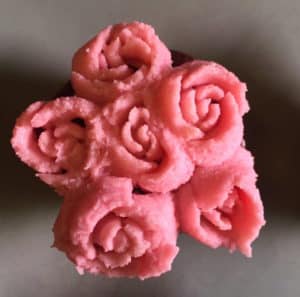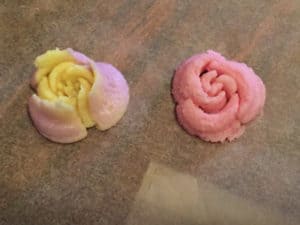
Cupcakes – Diet Compliance: GFCF/SCD/GAPS/LOD/Paleo/Nut-Free
Frosting – Diet Compliance: GFCF (see further ideas below)
These cupcakes are certainly not only for Mother’s Day, but the floral design lends itself so nicely to springtime and Mother’s Day.
What makes these cupcakes festive is the floral frosting details. These flowers require special frosting piping tips. So you’ll need to plan ahead a little.
I wanted to share my Coconut Flour Cupcake recipe, and how we made ours. My 9 year old daughter and I made these. In fact, the pink one in this photo she decorated.
In this case we made mini cupcakes, and chocolate sponge. I like minis because I can get the flavor and pleasure with less sugar. Although, I think the regular size are even prettier with more flowers and even room for piped leaves. If you want to make yours Chocolate add 1/4 cup of unsweetened cocoa. I am sharing the vanilla version because it has more dietary compliance with low oxalate and Specific Carbohydrate Diet (SCD)/GAPS Diet. Any cupcakes will work, but I do love these.
The texture is very forgiving. Coconut flour makes a cake fluffier and lighter than almond flour. The vanilla is strong and delicious in this recipe.
Coconut Flour Cupcakes
Ingredients
- 1 ¼ cups coconut flour
- 1 teaspoon sea salt
- 1/2 teaspoon baking soda
- 8 large pastured eggs
- 2/3 cup melted grass-fed ghee (use coconut oil if you need to be dairy-free)
- 1 cup raw honey
- 2 tablespoon vanilla extract
Preheat the oven to 330 degrees. Grease and flour two 8-inch cake pans. In a large bowl, combine the coconut flour, salt, and baking soda. In a medium bowl, whisk together the eggs, melted ghee, honey and vanilla extract. Blend the wet ingredients into the coconut flour mixture with a handheld mixer until thoroughly combined.
Bake for 18-23 minutes, less for minis. Once inserted toothpick comes out dry (a few moist crumbs), cake is ready. Let cook in pan, then cool on rack. Frost after cake is cool.
Buttercream Frosting
I used regular buttercream with these because this was the first time we were using these new piping tips so I wanted to go with a frosting I know pipes well. Butter makes the best buttercream, but avoid butter if you diet is casein-free. I find ghee is often tolerated if it’s “certified casein-free,” but if someone has allergies to dairy, avoid ghee too. Coconut oil will work just fine.
Next time we’ll experiment. We want to make a sugar-free dairy-free “buttercream” frosting with powdered Lakanto and coconut oil next, in order to make it low sugar and Keto compliant. And we want to try a cooked buttercream frosting with honey to see if we can make one SCD and GAPS compliant.
Consider making a double batch of frosting if you want to make several colors of flowers. You’ll need the extra volume in the piping bags.
Ingredients
1 pound of powdered sugar (approximately 4 cups)
¼-½ teaspoon salt (personally I like ½ teaspoon)
1/2 cup ghee, coconut oil, or palm oil (ghee is made from butter, avoid if strict dairy-free is necessary)
¼ cup non-dairy milk
1 ½ teaspoons vanilla
natural coloring
Cream ghee or oil in bowl – by hand, with an electric hand mixer, or stand mixer. If you use a stand mixer use the paddle attachment (not whisk).
Beat the butter for 3 minutes to make it a bit fluffy.
Measure the milk and add the salt to the milk to dissolve it, and then set it aside.
Add the sugar in two parts. Sift the first half of the powdered sugar into the mixing bowl with the butter, along with the vanilla and half the milk. Beat for 3 minutes.
Sift the remainder of the sugar to the mixing bowl, add any food coloring, and an additional tablespoon of milk (do not pour the milk all at once). Beat for 3 minutes.
Add any additional milk little by little, as needed, until you reach the desired consistency.
 Remember, the natural coloring will add liquid so don’t add it at the very end or it might make the frosting too soft for decorating.
Remember, the natural coloring will add liquid so don’t add it at the very end or it might make the frosting too soft for decorating.
And one more thing, always use natural coloring, not conventional food dye. The natural colors look great, especially for florals where pastels look beautiful (and they are much better for you and your children). Those pictured here are all made with natural plant-based colors, and they came out very vibrant.
Decorating the cupcakes
Decorating them is my favorite part!
As I mentioned up front, these flowers require special frosting piping tips. They are called Russian Piping Tips. They sell them at Michael’s and other craft/baking supply stores, as well as some major online retails that ship overnight, so you can get them the same day or next day, but planning ahead is always a good idea. They often come in a pack of 12 and there are many great videos online on how to use them.
But the gist is fairly simple, place the nozzle the piping bag (with or without a coupler) fill a piping bag with frosting.
 To pipe, position vertically, place against cupcake and squeeze piping bag. One it begins to adhere to the cupcake pull up and release the pressure slowly. One press makes a whole flower.
To pipe, position vertically, place against cupcake and squeeze piping bag. One it begins to adhere to the cupcake pull up and release the pressure slowly. One press makes a whole flower.
One of my favorite techniques is to spread one color up the insides of the piping back, and then scoop a different color into the center. It comes out two-toned like my purple and yellow one.
You can practice on some wax paper as we did.
Hope you enjoy them! Share your results with us.
Amazon Disclaimer: Julie Matthews and Nourishing Hope is a participant in the Amazon Services LLC Associates Program, an affiliate advertising program designed to provide a means for sites to earn advertising fees by advertising and linking to Amazon.com.
FTC Disclaimer: Some links may be affiliate links. We may get paid if you buy something or take an action after clicking one of these.




0 Comments